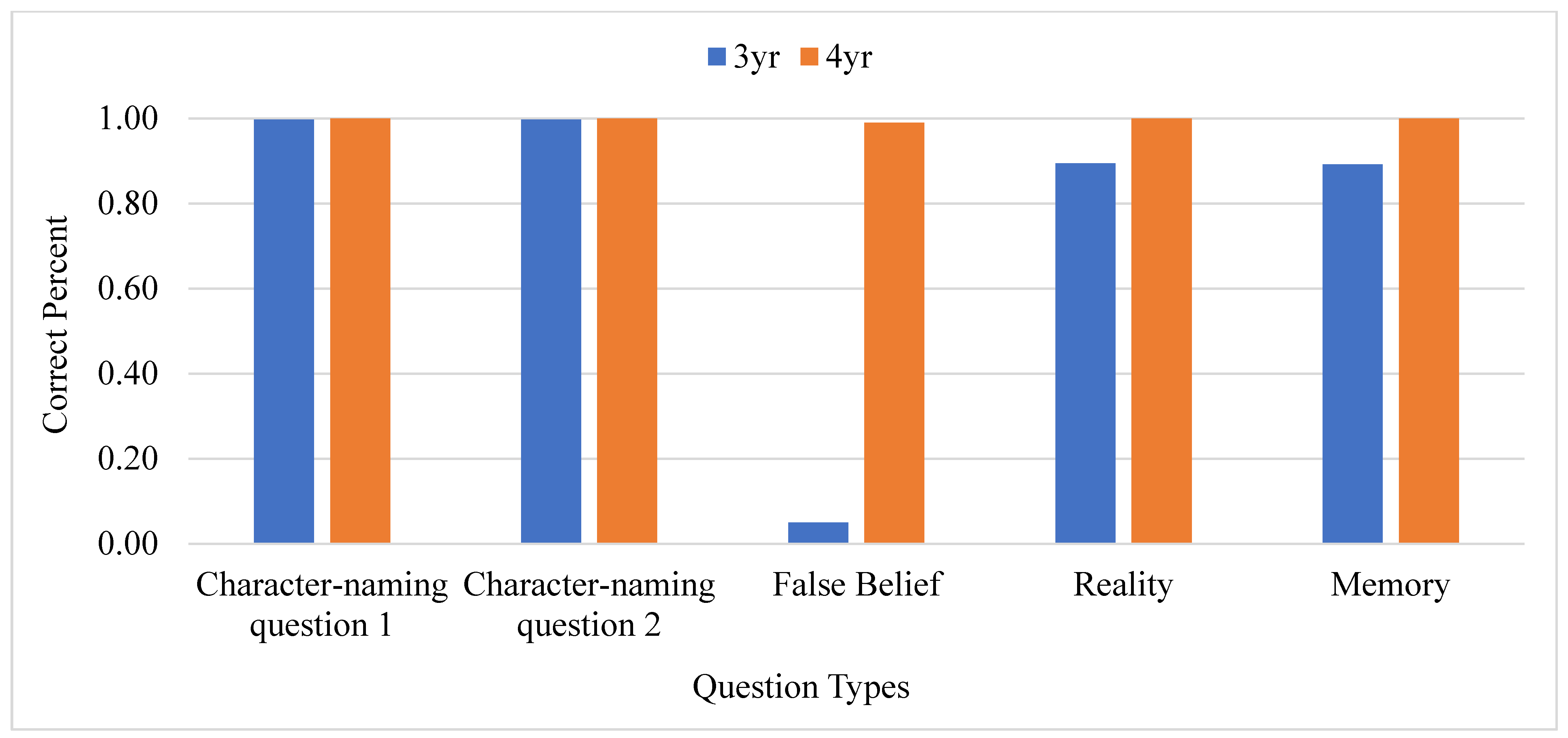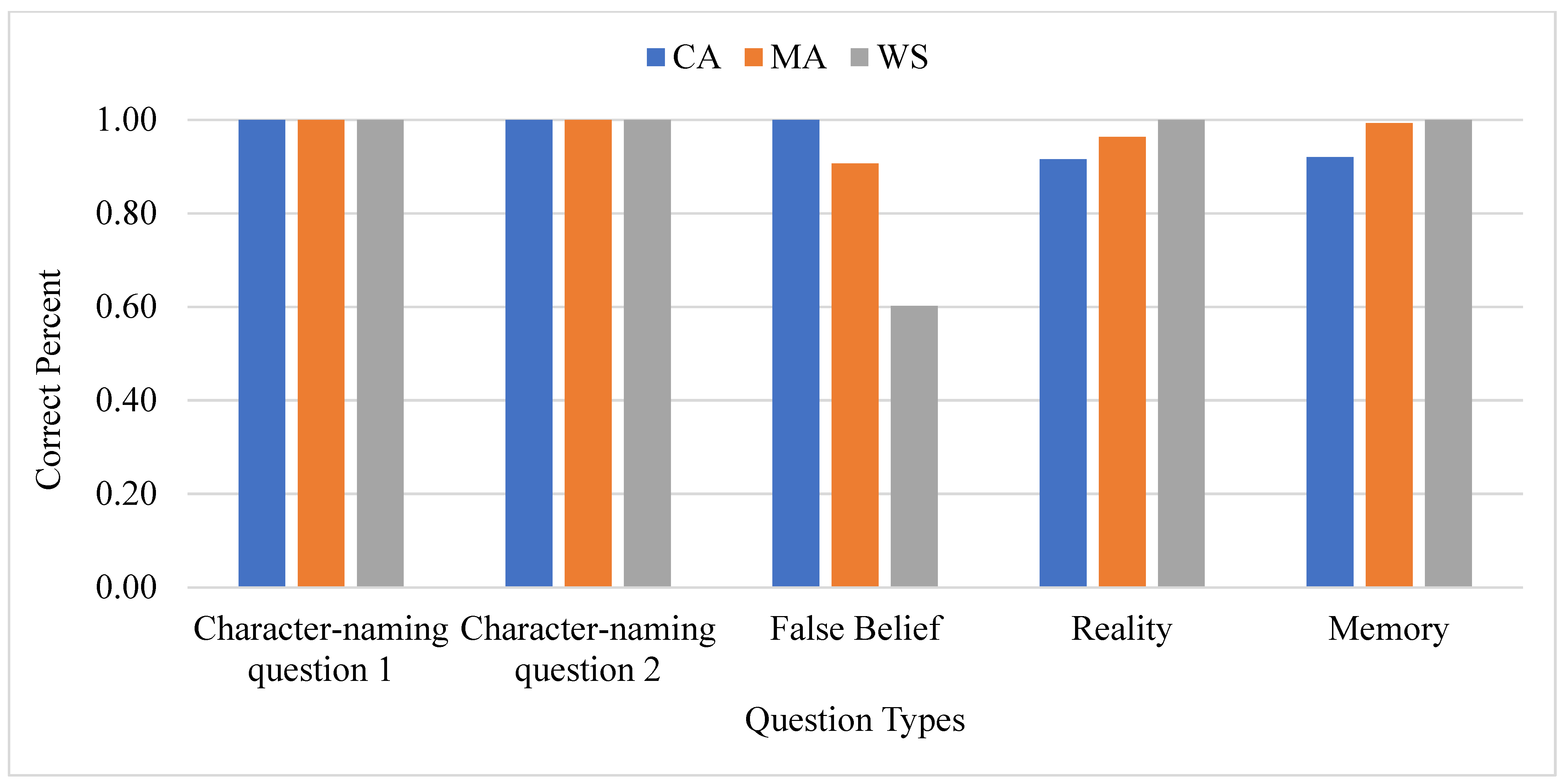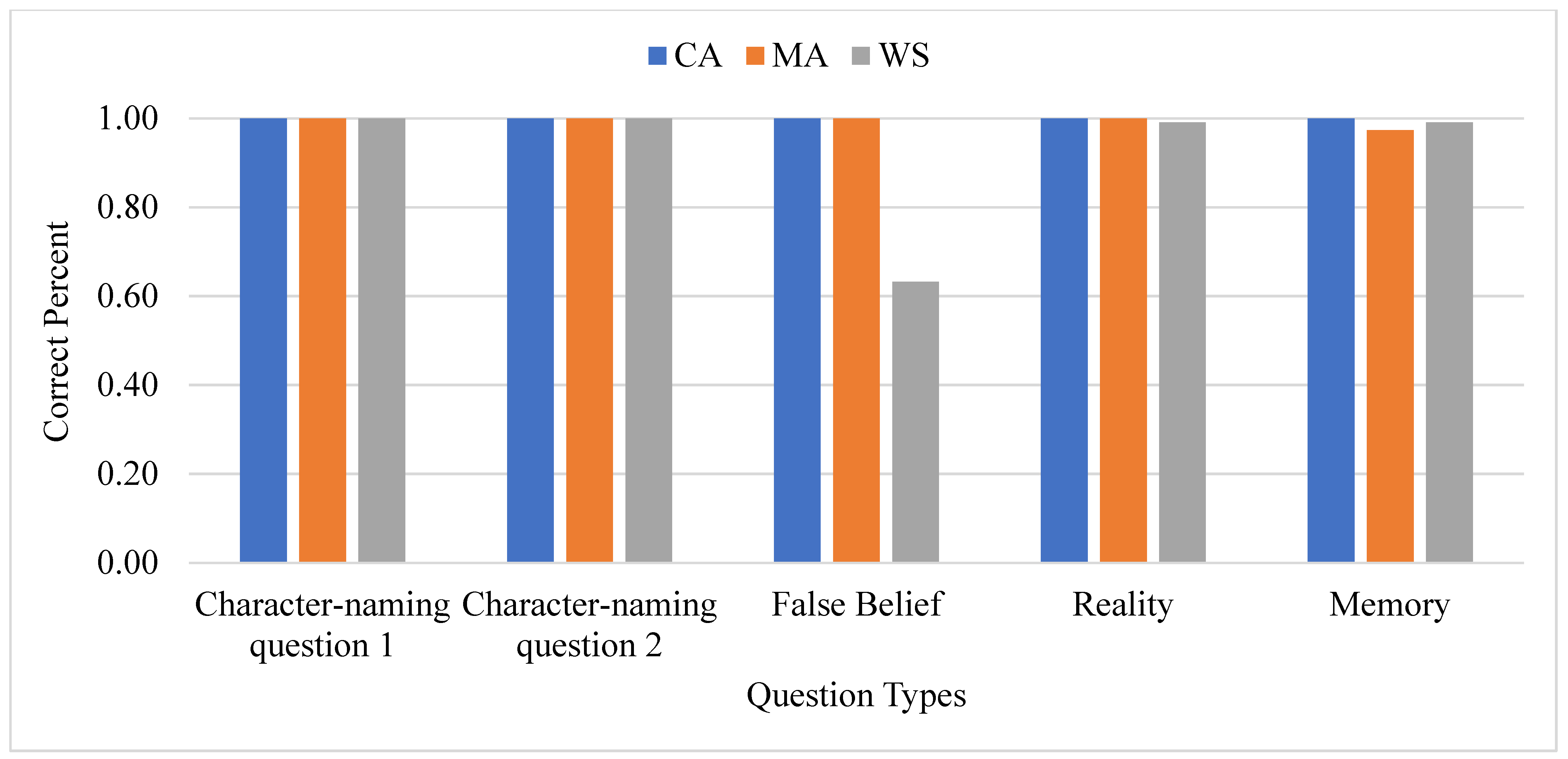Computerized False Belief Tasks Impact Mentalizing Ability in People with Williams Syndrome
Abstract
1. Introduction
2. Method
2.1. Participants
2.2. Materials and Design
2.3. Procedure
3. Results
3.1. Analyses of Healthy 3- and 4-Year-Old Controls
3.2. Analyses of the Unexpected Location-Change Task
3.3. Analyses of the Unexpected Content-Change Task
4. Discussion
Supplementary Materials
Author Contributions
Funding
Institutional Review Board Statement
Informed Consent Statement
Data Availability Statement
Acknowledgments
Conflicts of Interest
References
- Premack, D.; Woodruff, G. Does the chimpanzee have a theory of mind? Behav. Brain Sci. 1978, 1, 515–526. [Google Scholar] [CrossRef]
- Wimmer, H.; Perner, J. Beliefs about beliefs: Representation and constraining function of wrong beliefs in young children’s understanding of deception. Cognition 1983, 13, 103–128. [Google Scholar] [CrossRef] [PubMed]
- Morris, C.A. Williams Syndrome. In Gene Reviews; Adam, M.P., Everman, D., Mirzaa, G., Pagon, R., Wallace, S., Bean, L., Gripp, K., Amemiya, A., Eds.; University of Washington: Seattle, WA, USA, 1999. [Google Scholar]
- Bellugi, U.; Korenberg, J.R.; Klima, E.S. Williams syndrome: An exploration of neurocognitive and genetic features. J. Clin. Neurosci. Res. 2001, 1, 217–229. [Google Scholar]
- Bellugi, U.; Lichtenberger, L.; Jones, W.; Lai, Z.; St George, M. The neurocognitive profile of Williams syndrome: A complex pattern of strengths and weaknesses. J. Cogn. Neurosci. 2000, 12, 7–29. [Google Scholar] [CrossRef]
- Baron-Cohen, S.; Leslie, A.M.; Frith, U. Does the autistic child have a “theory of mind”? Cognition 1985, 21, 37–46. [Google Scholar] [CrossRef]
- Gopnik, A.; Aslington, J.W. Children’s understanding of representational change and its relation to the understanding of false belief and the appearance-reality distinction. Child Dev. 1988, 59, 26–37. [Google Scholar] [CrossRef]
- Karmiloff-Smith, A.; Klima, E.; Bellugi, U.; Grant, J.; Baron-Cohen, S. Is there a social module? Language, face processing, and theory of mind in individuals with Williams syndrome. J. Cogn. Neurosci. 1995, 7, 196–208. [Google Scholar] [CrossRef]
- Tager-Flusberg, H.; Boshart, J.; Baron-Cohen, S. Reading the windows to the soul: Evidence of domain-specific sparing in Williams syndrome. J. Cogn. Neurosci. 1998, 10, 631–639. [Google Scholar] [CrossRef]
- Tager-Flusberg, H.; Sullivan, K. A componential view of theory of mind: Evidence from Williams syndrome. Cognition 2000, 76, 59–89. [Google Scholar]
- Karmiloff-Smith, A. Beyond Modularity: A Developmental Perspective on Cognitive Science; MIT Press: Cambridge, UK, 1992. [Google Scholar]
- Karmiloff-Smith, A. Development itself is the key to understanding developmental disorders. Trends Cogn. Sci. 1998, 2, 389–398. [Google Scholar] [CrossRef]
- Hsu, C.F. Is the contextual effect weak in people with Williams syndrome? An investigation of information integration ability using pictures. Res. Dev. Disabil. 2013, 34, 932–939. [Google Scholar] [PubMed]
- Hsu, C.F. New Pathways of Brain Plasticity on People with Developmental Disabilities: A Review of Cognitive Interventions with Technologies. Glob. J. Intellect. Dev. Disabil. 2021, 9, 555756. [Google Scholar]
- Golan, O.; Baron-Cohen, S. Systemizing empathy: Teaching adults with Asperger syndrome or high- functioning autism to recognize complex emotions using interactive multimedia. Dev. Psychopathol. 2006, 18, 591–617. [Google Scholar] [CrossRef] [PubMed]
- Soares, E.; Bausback, K.; Beard, C.L.; Higinbotham, M.; Bunge, E.L.; Gengoux, G.W. Social skills training for autism spectrum disorders: A meta-analysis of in-person and technological interventions. J. Technol. Behav. Sci. 2021, 6, 166–180. [Google Scholar] [CrossRef]
- Fisher, M.H.; Morin, L. Addressing social skills deficits in adults with Williams syndrome. Res. Dev. Disabil. 2017, 71, 77–87. [Google Scholar]
- Laugeson, E.A.; Frankel, F. Social Skills for Teenagers with Developmental and Autism Spectrum Disorders: The PEERS Treatment Manual; Routledge: New York, NY, USA, 2010. [Google Scholar]
- UNICEF Health and Family Life Education (HFLE) Common Curriculum: Self and Interpersonal Relationships Theme Unit. 2009. Available online: www.educan.org/sites/educan.org/files/SIP_1.pdfwww.educan.org/sites/educan.org/files/SIP_1.pdf (accessed on 16 May 2017).
- Winner, M.G. Think Social! A Social Thinking Curriculum for School-Age Students; Think Social Publishing: Santa Clara, CA, USA, 2008. [Google Scholar]
- Fisher, M.H.; Kammes, R.R.; Black, R.S.; Cwiakala, K. A distance-delivered social skills program for young adults with Williams syndrome: Evaluating feasibility and preliminary efficacy. J. Autism Dev. Disord. 2022, 52, 5162–5176. [Google Scholar]
- Hsu, C.F.; Karmiloff-Smith, A.; Tzeng, O.; Chin, R.T.; Wang, H.C. Semantic knowledge in Williams syndrome: Insights from comparing behavioural and brain processes in false memory tasks. In Proceedings of the 2007 IEEE 6th International Conference on Development and Learning, London, UK, 11–13 July 2007; Volume 6, pp. 48–52. [Google Scholar]
- Hsu, C.F.; Karmiloff-Smith, A. Language and Williams syndrome. Annu. Rev. Appl. Linguist. 2008, 28, 191–204. [Google Scholar]
- Hsu, C.F. Contextual integration of causal coherence in people with Williams syndrome. Res. Dev. Disabil. 2013, 34, 3332–3342. [Google Scholar]
- Hsu, C.F. Cross-modal contextual coherence of semantic integration in people with Williams syndrome. Res. Dev. Disabil. 2013, 34, 4319–4327. [Google Scholar]
- Hsu, C.F. Cross-domain investigation of weak central coherence in people with Williams syndrome: Asymmetrical brain and behavioural performances in verbal and nonverbal domains. In Semantic Memory: Neurobiology, Disorders and Therapeutic Strategies for Improvement; Porter, O.H., Ed.; Nova Science Publishers: Hauppauge, NY, USA, 2014; pp. 71–82. [Google Scholar]
- Hsu, C.F. Modality effect of contextual integration in people with Williams syndrome. Res. Dev. Disabil. 2014, 35, 1571–1578. [Google Scholar]
- Hsu, C.F. Contextual coherence of information integration in people with Williams syndrome: Implications for cognitive interventions. In Proceeding of the 15th International Symposium on Chinese Languages and Linguistics, Hsinchu, Taiwan, 27–29 May 2016. [Google Scholar]
- Hsu, C.F. Semantic priming and associative priming in people with Williams syndrome. In Advances in Health and Disease; Duncan, L.T., Ed.; Nova Science Publisher: Hauppauge, NY, USA, 2017; Volume 2, pp. 171–196. [Google Scholar]
- Hsu, C.F. Neural correlates of causal inferences and semantic priming in people with Williams syndrome: An fMRI study. J. Intellect. Disabil.-Diagn. Treat. 2020, 8, 698–709. [Google Scholar] [CrossRef]
- Hsu, C.F. Understanding emotion language through events and words in people with Williams syndrome. Child Neuropsychol. 2020, 26, 1091–1111. [Google Scholar] [CrossRef]
- Hsu, C.F. Contextual effects on figurative processing of nouns and verbs in people with Williams syndrome. Res. Dev. Disabil. 2023, 134, 104429. [Google Scholar] [CrossRef] [PubMed]
- Hsu, C.F.; Chen, J.Y. Deviant neural correlates of configural detection in facial processing of people with Williams syndrome. Bull. Spec. Educ. 2014, 39, 61–84. [Google Scholar]
- Hsu, C.F.; Tzeng, O. Contextual effect in people with Williams syndrome. Res. Dev. Disabil. 2011, 32, 781–787. [Google Scholar]
- Van Herwegen, J.; Dimitriou, D.; Rundblad, G. Performance on verbal and non-verbal false belief tasks: Evidence from children with Williams syndrome. J. Commun. Disord. 2013, 46, 440–448. [Google Scholar] [CrossRef] [PubMed]
- Hsu, C.F.; Lv, P. Emotion Priming in People with Williams Syndrome. Brain Sci. 2023, 13, 467. [Google Scholar]
- Mills, D.L.; Alvarez, T.D.; St George, M.; Appelbaum, L.G.; Bellugi, U.; Neville, H. Electrophysiological studies of face processing in Williams syndrome. J. Cogn. Neurosci. 2000, 12 (Suppl. S1), 47–64. [Google Scholar] [CrossRef]
- Einfeld, S.T.; Tonge, B.J.; Florio, T. Behavioral and emotional disturbance in individuals with Williams syndrome. Am. J. Ment. Retard. 1997, 102, 45–53. [Google Scholar] [CrossRef]
- Hsu, C.F.; Lv, P. Investigating basic emotions in people with Williams syndrome. Res. Dev. Disabil. 2022, 129, 104308. [Google Scholar]
- Garfield, J.L.; Peterson, C.C.; Perry, T. Social cognition, language acquisition and the development of the theory of mind. Mind Lang. 2001, 6, 494–541. [Google Scholar] [CrossRef]
- Pavlova, M.A.; Heiz, J.; Sokolov, A.N.; Barisnikov, K. Social cognition in Williams syndrome: Face tuning. Front. Psychol. 2016, 7, 1131. [Google Scholar] [PubMed]
- Campos, R.; Castilla-Martinez, P.; Sotillo, M. False belief attribution in children with Williams syndrome: The answer is in the emotion. J. Intellect. Disabil. Res. 2017, 61, 1003–1010. [Google Scholar] [CrossRef] [PubMed]



| Task | Group | N | F:M | Mean CA (SD) | Range | Mean MA (SD) | Range | Statistical Results |
|---|---|---|---|---|---|---|---|---|
| Unexpected Location Task | CA | 22 | 12:10 | 9.9 (3.3) | 5.7–18.7 | CA vs. MA, t(21) = 10.080, p < 0.001 CA vs. WS-CA, t(21) = −0.084, p = 0.934 CA vs. WS-MA, t(21) = 10.560, p < 0.001 | ||
| MA | 22 | 12:10 | 6.3 (2.3) | 3.8–12.2 | MA vs. WS-CA, t(21) = −11.139, p < 0.001 MA vs. WS-MA, t(21) = −0.902, p = 0.377 | |||
| WS | 22 | 12:10 | 9.9 (3.1) | 5.9–18.1 | 6.4 (2.4) | 3.8–12.3 | ||
| 3 years old | 20 | 10:10 | 3.4 (0.2) | 3.0–3.6 | 3 years old vs. 4 years old, t(19) = 16.998, p < 0.001 | |||
| 4 years old | 20 | 10:10 | 4.2 (0.2) | 4.0–4.6 | ||||
| Unexpected Content Task | CA | 17 | 8:9 | 10.4 (3.5) | 6.3–18.7 | CA vs. MA, t(16) = 8.674, p < 0.001 CA vs. WS-CA, t(16) = 0.086, p = 0.933 CA vs. WS-MA, t(16) = 5.555, p < 0.001 | ||
| MA | 17 | 8:9 | 6.6 (2.4) | 4.0–12.2 | MA vs. WS-CA, t(16) = −5.567, p < 0.001 MA vs. WS-MA, t(16) = −0.108, p = 0.916 | |||
| WS | 17 | 8:9 | 10.3 (3.3) | 6.6–18.1 | 6.7 (2.4) | 4.0–12.3 | ||
| 3 years old | 20 | 10:10 | 3.4 (0.2) | 3.0–3.6 | 3 years old vs. 4 years old, t(19) = 6.998, p < 0.001 | |||
| 4 years old | 20 | 10:10 | 4.2 (0.2) | 4.0–4.6 |
| Structure | Contexts |
|---|---|
| General Setting | 唐老鸭和米老鼠一起坐在阳台上晒太阳。 Donald Duck and Mickey Mouse sat on the balcony and enjoyed a sunbath. |
| Action | 唐老鸭把花放进篮子里。 Donald Duck put the flowers in the basket. |
| Motivation (three actions) | 唐老鸭和米老鼠坐了一会,唐老鸭觉得有点渴,想去喝水。 Donald Duck and Mickey Mouse sat for a while (verb 1). Donald Duck was thirsty (verb 2) and went to drink water (verb 3). |
| Confirmed Motivation Action | 唐老鸭离开阳台,喝水去了。 Donald Duck left the balcony and went to drink water. |
| Left Character | 这时,阳台上只剩下米老鼠。 At this time, only Mickey Mouse was left on the balcony. |
| Key Actions (one setting + three actions) | 米老鼠很调皮,把花从篮子里拿出来,放进柜子里,再关上柜门。 Mickey Mouse was very naughty. He took the flowers out of the basket, put them in the cabinet, and then closed the door. |
| False Belief-Inducing Setting | 过了一会,唐老鸭回到阳台,想闻闻花香。 After a while, Donald Duck returned to the balcony and wanted to smell the flowers. |
| Attention Arousing Greeting | 好,小朋友, OK, dear, |
| Recognition Question 1 | 你知道哪个是唐老鸭? Do you know which character Donald Duck is? |
| Recognition Question 2 | 你知道哪个是米老鼠? Do you know which character Mickey Mouse is? |
| Belief Question | 唐老鸭喝完水,回到阳台,唐老鸭会去哪里找花? Donald Duck finished drinking water and went back to the balcony. Where would Donald Duck look for flowers? |
| Reality Question | 现在花在哪里? Where are the flowers now? |
| Memory Question | 一开始唐老鸭把花放在哪里? Where did Donald Duck put the flowers at first? |
| Structure | Contexts |
|---|---|
| General Setting | 喜羊羊和灰太狼一起来到图书馆。 A pleasant goat and grey wolf came to the library together. |
| Action | 他们在图书馆里准备看书。 They are ready to read the books in the library. |
| Motivation (three actions) | 翻开书,喜羊羊和灰太狼有点看不清,想找副眼镜。 Opening the books, the pleasant goat and grey wolf could not see clearly. |
| Confirmed Motivation Action | 于是,喜羊羊离开图书馆,去找眼镜。 So, the pleasant goat left the library to look for eyeglasses. |
| Left Character | 这时,图书馆里只剩下灰太狼。 At this time, only the grey wolf was left in the library. |
| Key Actions (one setting; three actions) | 喜羊羊回到图书馆,把眼镜盒放到灰太狼面前。这时候灰太狼要去拿书包,灰太狼离开了图书馆。 The pleasant goat returned to the library and put the eyeglasses box in front of the the grey wolf. Meanwhile, the grey wolf was going to get his school bag. Grey wolf left the library. |
| False Belief-Inducing Setting | 哇,喜羊羊真调皮,居然把饼干装在眼镜盒里。 Wow, the pleasant goat was so naughty that he put cookies in his eyeglasses box. |
| Attention Arousing Greeting | 好,小朋友, OK, dear, |
| Recognition Question 1 | 你知道哪个是喜羊羊? Do you know which character the pleasant goat is? |
| Recognition Question 2 | 你知道哪个是灰太狼? Do you know which character the grey wolf is? |
| Belief Question | 灰太狼还没有打开过眼镜盒,灰太狼觉得眼镜盒里装的是什么? The grey wolf has not opened the eyeglasses box yet. What does the grey wolf think is in the eyeglasses box? |
| Reality Question | 现在你知道眼镜盒里装的是什么? What is in the eyeglasses box now? |
| Memory Question | 一开始喜羊羊去拿的眼镜盒里装的是什么? What was in the eyeglasses box when pleasant goat went to get it at first? |
Disclaimer/Publisher’s Note: The statements, opinions and data contained in all publications are solely those of the individual author(s) and contributor(s) and not of MDPI and/or the editor(s). MDPI and/or the editor(s) disclaim responsibility for any injury to people or property resulting from any ideas, methods, instructions or products referred to in the content. |
© 2023 by the authors. Licensee MDPI, Basel, Switzerland. This article is an open access article distributed under the terms and conditions of the Creative Commons Attribution (CC BY) license (https://creativecommons.org/licenses/by/4.0/).
Share and Cite
Hsu, C.-F.; Rao, S.-Y. Computerized False Belief Tasks Impact Mentalizing Ability in People with Williams Syndrome. Brain Sci. 2023, 13, 722. https://doi.org/10.3390/brainsci13050722
Hsu C-F, Rao S-Y. Computerized False Belief Tasks Impact Mentalizing Ability in People with Williams Syndrome. Brain Sciences. 2023; 13(5):722. https://doi.org/10.3390/brainsci13050722
Chicago/Turabian StyleHsu, Ching-Fen, and Shi-Yu Rao. 2023. "Computerized False Belief Tasks Impact Mentalizing Ability in People with Williams Syndrome" Brain Sciences 13, no. 5: 722. https://doi.org/10.3390/brainsci13050722
APA StyleHsu, C.-F., & Rao, S.-Y. (2023). Computerized False Belief Tasks Impact Mentalizing Ability in People with Williams Syndrome. Brain Sciences, 13(5), 722. https://doi.org/10.3390/brainsci13050722





